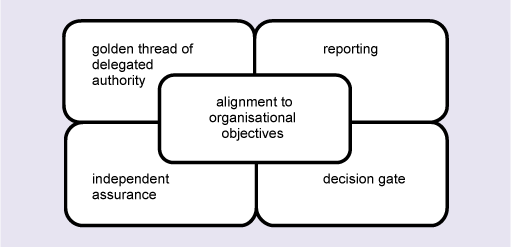1 Governance
The governance of a project is much like the governance of an organisation.
Project governance is:
The set of policies, regulations, functions, processes, and procedures and responsibilities that define the establishment, management and control of projects, programmes or portfolios.
Some projects are run solely by the project manager. Where this is appropriate for the type of project, and the organisation, it is not necessary to have all the aspects of governance that are discussed in this section.
Figure 1 illustrates good governance as explained by Murray (2011). Murray’s explanation is compatible with the APM definition but focuses just on projects rather than including programmes or portfolios too. He gives five elements, based on project governance or project management governance, with emphasis on alignment to organisational objectives as a central aspect of good governance. He uses the term ‘decision gate’ in place of a stage gate or approval gate.
- Alignment to organisational objectives means that the projects undertaken by an organisation should be able to demonstrate, in the business case, the contribution to the organisation’s objectives. With this contribution clearly stated then the project context is clear and governance of the project can ensure that the project is focused on the outcome rather than activities.
- The golden thread of delegated authority is a direct chain of accountability. Within this chain each person needs to know what their authority is and what needs to be referred to a higher level of authority within the chain.
- Reporting – those to whom responsibilities have been delegated should periodically report on progress. In addition to period reporting, additional reports need to be made if the person with delegated responsibility is unable to fulfil that responsibility, or if conflicts of interest arise.
- Independent assurance is a counterbalance to self-reporting, and is an independent check of the structures and processes to review whether the objectives will be met.
- Decision gates – at specified points in the project life cycle − provide formal points of control where a decision is made to grant or renew authority for the project to continue.
The strategic management of an organisation identifies and implements the long-term goals of that organisation. The choice of projects (in programmes or portfolios if appropriate), and carrying them out successfully, is part of the organisation’s activities to achieve those goals. Therefore the organisation, at the strategic level, typically needs to establish the governance structures for the management of projects. Organisations have corporate governance, of which project governance is a subset. Project management incorporates those aspects of project governance that are at the project level, as well as managing the detail of the project.
The APM identifies the following ways in which good governance can be demonstrated:
- The adoption of a disciplined life cycle governance that includes approval gates at which viability is reviewed and approved.
- Recording and communicating decisions made at approval gates.
- The acceptance of responsibility by the organisation’s management board for project governance.
- Establishing clearly defined roles, responsibilities and performance criteria for governance.
- Developing coherent and supportive relationships between business strategy and projects.
- Procedures that allow a management board to call for an independent scrutiny of projects.
- Fostering a culture of improvement and frank disclosure of project information.
- Giving members of delegated bodies the capability and resources to make appropriate decisions.
- Ensuring that business cases are supported by information that allows reliable decision making.
- Ensuring that stakeholders are engaged at a level that reflects their importance to the organisation and in a way that fosters trust.
- The deployment of suitably qualified and experienced people.
- Ensuring that project management adds value.
You will see from this list that demonstrating good governance is about clarity of roles and responsibilities, about processes, and about the relationships between people and within an organisation. The list is applicable for any context and any size of project, and other factors may be important for specific projects and specific contexts. A key factor is the role of the host organisation and the senior management. This applies whether the project reports directly to the board or through a management structure for programmes and/or portfolios of which the project might be a part. Organisations that are less oriented to projects may leave more of the project governance to the project team, which is acceptable provided this is agreed by the project sponsor. The project sponsor also needs to ensure that the agreed governance processes are being followed and this scrutiny should be carried out by someone external to the project team. This scrutiny is known as ‘project assurance’ and is likely to be part of the host organisation’s corporate quality assurance.
The APM also emphasises the importance of the relationship between the project sponsor and the project manager (APM, 2012a). Good inter-personal skills are needed, together with clarity about responsibilities. The project sponsor is accountable for the achievement of the project objectives as specified in the business case, and providing senior management level support for the project. The project manager is responsible for the daily management of the project. The appropriate choice of a project management approach or method can support the governance of projects by defining the structure for the management of the project, including options for customising or adapting the approach or method for the particular project.

